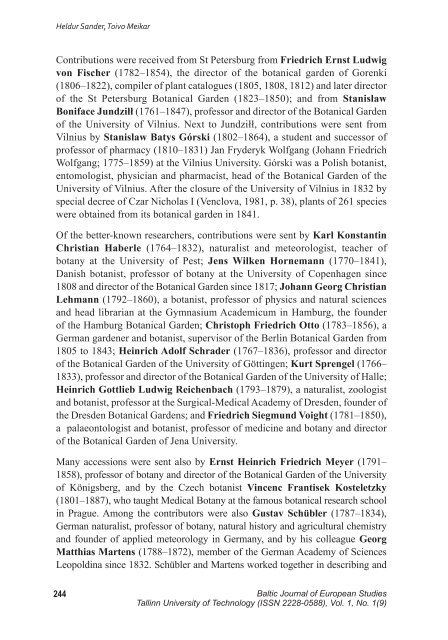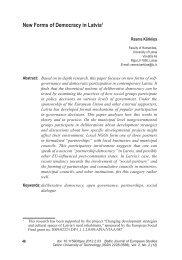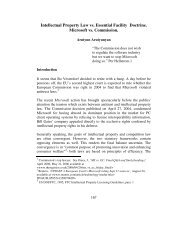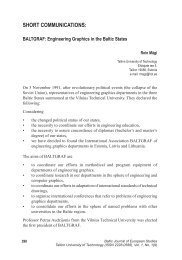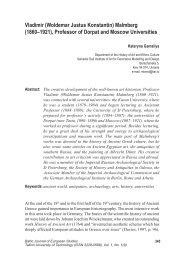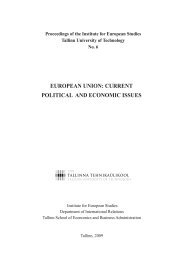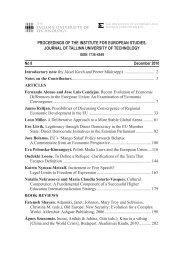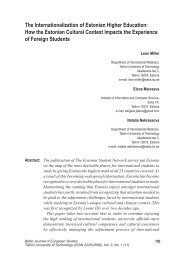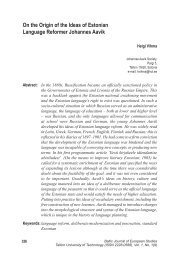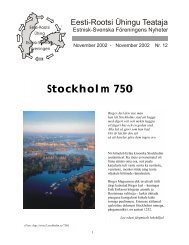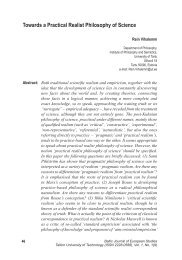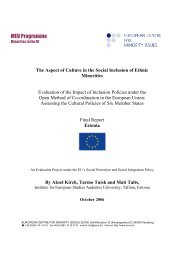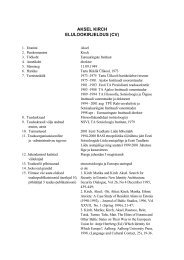Botanical Garden of the university of tartu (dorpat) - The Institute for ...
Botanical Garden of the university of tartu (dorpat) - The Institute for ...
Botanical Garden of the university of tartu (dorpat) - The Institute for ...
You also want an ePaper? Increase the reach of your titles
YUMPU automatically turns print PDFs into web optimized ePapers that Google loves.
Heldur Sander, Toivo Meikar<br />
Contributions were received from St Petersburg from Friedrich Ernst Ludwig<br />
von Fischer (1782–1854), <strong>the</strong> director <strong>of</strong> <strong>the</strong> botanical garden <strong>of</strong> Gorenki<br />
(1806–1822), compiler <strong>of</strong> plant catalogues (1805, 1808, 1812) and later director<br />
<strong>of</strong> <strong>the</strong> St Petersburg <strong>Botanical</strong> <strong>Garden</strong> (1823–1850); and from Stanisław<br />
Boniface Jundziłł (1761–1847), pr<strong>of</strong>essor and director <strong>of</strong> <strong>the</strong> <strong>Botanical</strong> <strong>Garden</strong><br />
<strong>of</strong> <strong>the</strong> University <strong>of</strong> Vilnius. Next to Jundziłł, contributions were sent from<br />
Vilnius by Stanislaw Batys Górski (1802–1864), a student and successor <strong>of</strong><br />
pr<strong>of</strong>essor <strong>of</strong> pharmacy (1810–1831) Jan Fryderyk Wolfgang (Johann Friedrich<br />
Wolfgang; 1775–1859) at <strong>the</strong> Vilnius University. Górski was a Polish botanist,<br />
entomologist, physician and pharmacist, head <strong>of</strong> <strong>the</strong> <strong>Botanical</strong> <strong>Garden</strong> <strong>of</strong> <strong>the</strong><br />
University <strong>of</strong> Vilnius. After <strong>the</strong> closure <strong>of</strong> <strong>the</strong> University <strong>of</strong> Vilnius in 1832 by<br />
special decree <strong>of</strong> Czar Nicholas I (Venclova, 1981, p. 38), plants <strong>of</strong> 261 species<br />
were obtained from its botanical garden in 1841.<br />
Of <strong>the</strong> better-known researchers, contributions were sent by Karl Konstantin<br />
Christian Haberle (1764–1832), naturalist and meteorologist, teacher <strong>of</strong><br />
botany at <strong>the</strong> University <strong>of</strong> Pest; Jens Wilken Hornemann (1770–1841),<br />
Danish botanist, pr<strong>of</strong>essor <strong>of</strong> botany at <strong>the</strong> University <strong>of</strong> Copenhagen since<br />
1808 and director <strong>of</strong> <strong>the</strong> <strong>Botanical</strong> <strong>Garden</strong> since 1817; Johann Georg Christian<br />
Lehmann (1792–1860), a botanist, pr<strong>of</strong>essor <strong>of</strong> physics and natural sciences<br />
and head librarian at <strong>the</strong> Gymnasium Academicum in Hamburg, <strong>the</strong> founder<br />
<strong>of</strong> <strong>the</strong> Hamburg <strong>Botanical</strong> <strong>Garden</strong>; Christoph Friedrich Otto (1783–1856), a<br />
German gardener and botanist, supervisor <strong>of</strong> <strong>the</strong> Berlin <strong>Botanical</strong> <strong>Garden</strong> from<br />
1805 to 1843; Heinrich Adolf Schrader (1767–1836), pr<strong>of</strong>essor and director<br />
<strong>of</strong> <strong>the</strong> <strong>Botanical</strong> <strong>Garden</strong> <strong>of</strong> <strong>the</strong> University <strong>of</strong> Göttingen; Kurt Sprengel (1766–<br />
1833), pr<strong>of</strong>essor and director <strong>of</strong> <strong>the</strong> <strong>Botanical</strong> <strong>Garden</strong> <strong>of</strong> <strong>the</strong> University <strong>of</strong> Halle;<br />
Heinrich Gottlieb Ludwig Reichenbach (1793–1879), a naturalist, zoologist<br />
and botanist, pr<strong>of</strong>essor at <strong>the</strong> Surgical-Medical Academy <strong>of</strong> Dresden, founder <strong>of</strong><br />
<strong>the</strong> Dresden <strong>Botanical</strong> <strong>Garden</strong>s; and Friedrich Siegmund Voight (1781–1850),<br />
a palaeontologist and botanist, pr<strong>of</strong>essor <strong>of</strong> medicine and botany and director<br />
<strong>of</strong> <strong>the</strong> <strong>Botanical</strong> <strong>Garden</strong> <strong>of</strong> Jena University.<br />
Many accessions were sent also by Ernst Heinrich Friedrich Meyer (1791–<br />
1858), pr<strong>of</strong>essor <strong>of</strong> botany and director <strong>of</strong> <strong>the</strong> <strong>Botanical</strong> <strong>Garden</strong> <strong>of</strong> <strong>the</strong> University<br />
<strong>of</strong> Königsberg, and by <strong>the</strong> Czech botanist Vincenc Frantisek Kosteletzky<br />
(1801–1887), who taught Medical Botany at <strong>the</strong> famous botanical research school<br />
in Prague. Among <strong>the</strong> contributors were also Gustav Schübler (1787–1834),<br />
German naturalist, pr<strong>of</strong>essor <strong>of</strong> botany, natural history and agricultural chemistry<br />
and founder <strong>of</strong> applied meteorology in Germany, and by his colleague Georg<br />
Matthias Martens (1788–1872), member <strong>of</strong> <strong>the</strong> German Academy <strong>of</strong> Sciences<br />
Leopoldina since 1832. Schübler and Martens worked toge<strong>the</strong>r in describing and<br />
244<br />
Baltic Journal <strong>of</strong> European Studies<br />
Tallinn University <strong>of</strong> Technology (ISSN 2228-0588), Vol. 1, No. 1(9)


